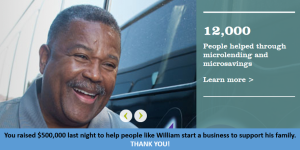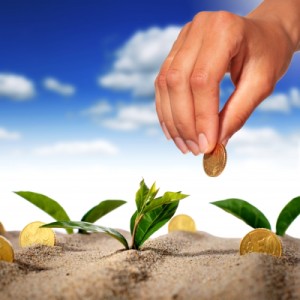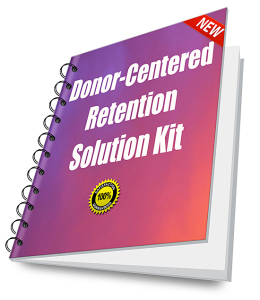Never think of your event as a stand-alone. That’s a waste of your time.
Always think in terms of “What’s next?”
Events Exist Within a Relationship-Building Context
You must always be cognizant of moving folks along a relationship continuum.
From awareness… to interest… to involvement… to investment.
Events create momentum to move folks along to the next point in the relationship continuum. If you don’t plan ahead to build on this momentum, your event attendees will get stuck in place.
Think in terms of next, depending on where your event attendees are along the relationship continuum.
- Some attendees may just be connecting with you for the first time. Your next goal with them is to get them more interested and involved.
- Other attendees will already be very involved with you (e.g. as donors, volunteers, or consumers). Your next goal with them is to get them to invest. Or to invest even more passionately than they’ve done up to this point.
Get your event attendees to think in terms of next too.
- You want new attendees to leave your event thinking “I’d really like to get more involved with them.”
- You want repeat attendees and current supporters to think “It’s time for me to really put my money where my mouth is.”
Once you’ve successfully planted that seed, it’s your job to feed and water it so it will grow. Otherwise, that seed is wasted.
Nurture the Seeds Planted by Your Event
1. Build follow-up into your event timeline
Block out time on your calendar ahead of time. Don’t make it an afterthought, or something you push to the back burner. Events without follow-up are like trees that fall in the forest when no one is there. It happened; so what? Big thud.
There’s no such thing as “mission accomplished” at 11:30 p.m. the night of your Gala. The day and the week following your fundraiser are critical to “cashing in” on all your hard work. If you wait until after the event to consider what to do next, you’ll likely squander much of the good will you built up the day of the event.
2. Gather information and feedback
One of the main reasons to host an event is to gather information. Imagine you’ve got a wicker basket, and you’re plopping fresh-picked ripe fruit into it. You’ve got to consume it before it rots.
- DONOR-FOCUSED DEBRIEFING
Assign top prospects to staff and/or volunteers for cultivation at the event. If you have a sit-down event, it may be useful to assign one point person at each table to be the chief listener/observer (e.g., Who seemed most moved by your video? Who clapped the loudest? Who raised their auction paddle most enthusiastically?).
After the event, check in with these folks to see what they learned. Enter relevant information into your database. Develop an individualized follow-up plan with each assigned prospect – and strike while the iron is hot. Some examples of well-placed follow-up might include:
“I hear from Susi that you’re interested in volunteering with our pet therapy program?”
“Tom let me know you have an expertise in commercial real estate. We’re looking to lease new office space… might we set up a chat? I’d love to learn more about what you do.”
“I so enjoyed meeting you at the Gala last week. Would you be interested in meeting for coffee to continue our conversation?”
” We’re holding a tour for folks who expressed interest at the event in learning more about our program. Would you be available on one of these dates?”
- OVERALL EVENT-FOCUSED DEBRIEFING
Bring your event team (staff and/or volunteers) together to evaluate the event (i.e., get this on your calendar ahead of time, ideally within one week of the event). Have an agenda, and put times to each agenda item, so you’ll stay on track. What worked? What didn’t? Don’t just focus on logistics, like whether the blue napkins looked good with the green tablecloths. Focus on the attendees. How many new people did you meet? Did you get to know ongoing supporters better? Did people seem happy? What seemed to resonate most with attendees, and how might you build on that? What are lessons learned for next time?
- EVENT ATTENDEE SURVEYS
Asking people to participate in a manner that doesn’t ask for money is a great way to engage folks, begin to build a relationship and learn more about what your supporters care about. You can:
(1) Send a quick written survey (either with your immediate thank you or a week later when you send information reporting on your event results) using something like Survey Monkey, KwikSurveys, Googledocs or Typeform (all have free versions);
(2) Randomly call a sampling of attendees and ask them if they have time to answer a few short questions to help you improve the event for next year, or
(3) Ask event attendees to complete a short survey before they leave. (e.g., What did they most enjoy – reception, food, entertainment, video, auction, people?; What did they learn that was new?; Would they recommend to a friend?, etc).
3. Say thank you
You can never thank too much.
The number one reason folks give for not giving again is that they weren’t thanked for their previous gift. And sometimes that means they don’t remember being thanked – because what you sent them seemed more like a receipt (e.g., “Your payment for two tickets has been received.”).
Don’t make the mistake of thinking you already thanked folks for buying a ticket, so now you’re done. Thank supporters for taking the time to attend and participate. And do it right away — before they forget they were there.
In fact, it’s important to plan ahead to thank everyone who made your event possible:
- THANK ATTENDEES (and donors who couldn’t make it)
The very least you can do is send a prompt post-event thank you email, which you can easily automate and set up in advance. Don’t forget that you can segment your attendee list and send a slightly different email to different groups (e.g., first-time attendees who paid; first-time attendees who came as guests; repeat attendees; table buyers; contributors who couldn’t attend, etc.).
The more you can personalize your post-event thank you, the better. I like to take snapshots of folks at the event; then send the photo to them with a handwritten personal note: “Looks like you were having a great time! Thanks so much for your support.” Or you can have volunteers call folks and leave a nice message. These personal touches make you stand out, and remind folks that they’ve joined a real community by virtue of their event participation.
- THANK VOLUNTEERS
Don’t forget to call and thank the folks who worked so hard to make your event possible. For those who worked especially hard, send a bouquet of flowers or give them a special gift – not expensive, but meaningful (e.g., a framed photo from the evening or a scrapbook of event memories).
- THANK SPONSORS AND VENDORS
The folks who underwrote your expenses all need thank you’s too. Perhaps send them a copy of the program, or a photo from the event which shows off their logo. Prepare copy in advance so you can get these out as soon as possible – you want to impress these investors so they’ll renew their support next year.
4. Share Event Results
Everyone wants to know how much the event raised. Tell them!
Make sure you tie the results to what the money will accomplish – because your mission is what will motivate folks to give again.
Send an email, but also put this information up on your website. Wherever you previously promoted the event (e.g., your home page; a special landing page), now use that real estate to showcase the results and say thanks. Consider a big photo showing off your mission (e.g., a still from a video you shared at the event; volunteers working; someone who will be helped as a result of the money raised). Try to stay away from photos of people standing at podiums speaking or sitting at tables eating.
5. Remind Donors They Were There
People like you to show them you know them. This is especially true if they already gave to you, and now you’re asking them to give again. You may know that most of the cost of their ticket, or their auction item purchase, wasn’t technically a charitable gift, but they don’t think of it this way. They want to be thanked for their generosity.
I like to create a special segment in annual campaigns of event attendees. All these folks get a special note from a volunteer that thanks them for attending the event, and encourages them to join the annual campaign this year as well.
6. Ask Donors to Get Involved With You Other Ways
This is a good strategy for any prospective lead, including folks who are currently simply following you on social media. Always ask yourself “What do I want this supporter to do next?” Then call for the action you desire.
People are looking for ways to become more meaningfully engaged. So invite event attendees to:
- Subscribe to your blog
- Share your event video with their friends
- Follow you on Pinterest or Instagram
- Sign a petition or pledge
- Watch a new video on YouTube or Vimeo
- Become a volunteer
Build a Donor Journey
You are a Sherpa. A journey guide. Supporters will engage with you in multiple ways, at multiple entry points, in their journey towards passionate investment in your cause. Your event is but one stop along the way. Your job is to assure it’s not the last stop – but just a stepping stone towards the next destination.
May your donors’ journeys be long and fruitful.
Want More on Strengthening Bonds with Donors?
Get your Donor Retention and Gratitude Playbook to develop your own step-by-step donor loyalty program! You’ll get everything you need to to make a great first impression — and then a terrific second, third and fourth impression. Buy each of the six volumes separately, or get them all in a discounted “Bargain Bundle” at more than 30% less than buying them individually. I promise this is an investment that will keep giving and giving. Not satisfied? All Clairification products come with a 30-day no-questions-asked money-back guarantee.
Images courtesy of Freedigitalphotos.net fantasista and Opportunity Fund.
This article originally appeared January 28, 2016 as a guest post on the Network for Good Nonprofit Marketing Blog.








I love reading your posts Claire! They are really full of insightful information. Thank you so much. This article was really helpful since our annual auction is coming up soon!